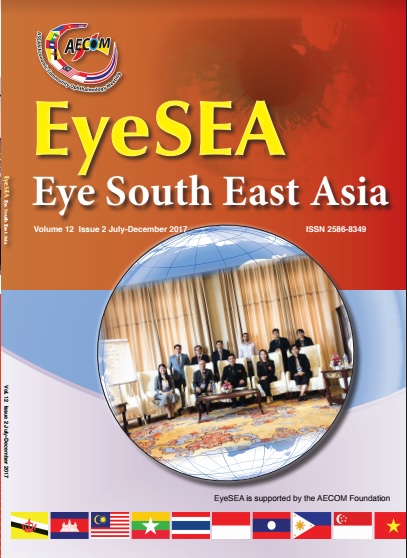The big deal with teaching direct ophthalmoscopy in medical students – one session in the community equals many sessions in the hospital outpatients department
Main Article Content
Abstract
Background: Fundoscopic examination with direct ophthalmoscopy is important for medical students. It can make an immediate diagnosis of a disease in the eye in addition to some systemic conditions. Skill is the factor that leads to success for fundus examination. Therefore, learning the utilization of a direct ophthalmoscope is essential for medical students.
Objective: To compare the effect of teaching environment on fifth year medical students’ preferences for learning direct ophthalmoscopy skills between community-based practice and hospital outpatient.
Type of study: Qualitative research, focused group discussion
Methods: Fifth year medical students of Thammasat University, Chumphon Khet Udomsakdi Hospital campus were enrolled in this study. All twelve medical students were divided into two groups and have learned the skill of direct ophthalmoscopy with patients in three-hour sessions for both in the community and hospital outpatients. Both groups were taught by the same ophthalmologist instructor. Focused group discussion was performed to assess the medical student’s skill and Self-confidence, Place and Timing, Patients and Knowledge Management of visual acuity (VA) testing.
Results: One-Hundred percent of students have concluded that the community based learning is better than hospital outpatients in almost all aspects. The skills gained in, self-confidence, place, timing, patients and knowledge management are superior in community based than hospital outpatients. Only 8.34% (one out of twelve) students reported no difference in the skill between community based and hospital outpatients.
Conclusion :Medical students learning in the community improved their skill and confidence with direct ophthalmoscopy more so than those learning in hospital outpatients and has used their knowledge in VA testing as opposed to depending outpatients nurses to perform VA testing. Therefore, these results may use to develop the teaching plan for medical students at Chumphon Khet Udomsakdi Hospital Medical Education Center in the future.
Article Details
References
Cordero I. Understanding and caring for the direct ophthalmoscope. Community Eye Health 2016;29(93):17.
Afshar AR, Oh FS, Birnbaum AD, Namavari A, Riddle JM, Djalilian AR. Assessing ophthalmoscopy skills. Ophthalmology. 2010 Sep;117(9):1863
Gupta RR, Lam WC. Medical students’ self-confidence in performing direct ophthalmoscopy in clinical training. Can J Ophthalmol. 2006;41(2):169-74.
Timberlake GT, Kennedy M. The direct ophthalmoscope how it works and how to use it. University of Kansas Medical Center. [Internet]. 2005. Available from:http://web.media.mit.edu/~raskar/Eye/TheDirectOphthalmoscope.pdf
Lederer A, Barry A, Chestnut K, Halbritter A, Fountaine JZ. [Internet]. Focus groups from A to Z: How to conduct focus groups to enhance college health practice. Health promotion section research committee. American college health association. 2014. Available from: http://www.acha.org/documents/Programs_Services/webhandouts_2014/TH4-114-Lederer_A.pdf.
Eliot & Associates. Guidelines for conducting a focus group. [Internet]. 2005. Available from: http://assessment.ass.duke.edu/documents/How_to_Conduct_a_Focus_Group.pdf.

